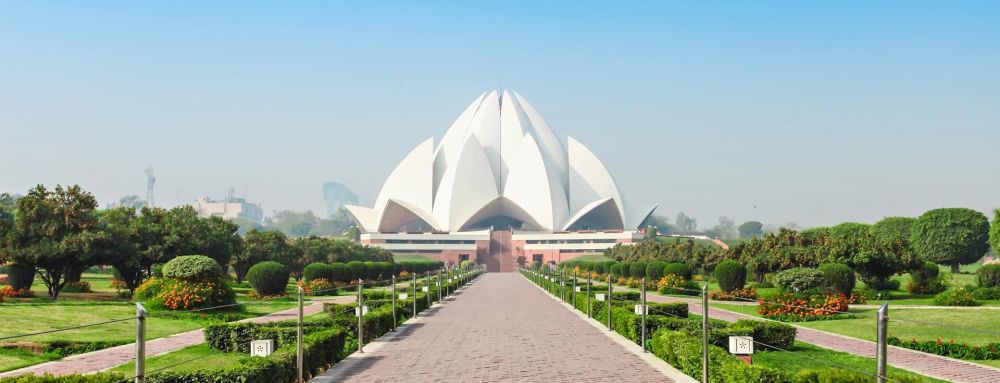

Visiting the Lotus Temple, also known as the Bahá'à House of Worship, is an experience of tranquility and architectural marvel. The temple is shaped like a lotus flower, a symbol of purity and peace, resonating with the Bahá'à principle of the Oneness of Religion. Visitors are encouraged to meditate or pray in the serene atmosphere of the main hall, which is devoid of any external distractions such as statues or religious texts. The temple's structure is surrounded by well-manicured gardens and pools, designed to enhance the aesthetic appeal and create an atmosphere conducive to contemplation. Its design is not only an architectural feat but also an embodiment of inclusivity, as people from all religious backgrounds are welcomed. The Lotus Temple is more than just a place of worship; it is a landmark promoting unity and harmony amidst the bustling city of Delhi.
Participate in a group meditation session at the Lotus Temple to experience the true essence of peace and harmony. These sessions are hinged on the principle of silence, allowing you to immerse yourself in personal reflection amidst the temple's serene environment. The temple's central hall is designed acoustically to enhance the silence, making it a perfect location for deep meditation. These sessions do not adhere to any particular religious practice or ritual, reflecting the temple's all-inclusive philosophy. You're invited to join others in a collective ambience of tranquility that transcends cultural and religious boundaries. Engaging in meditation here is not just a spiritual activity but an opportunity to connect with the universal human experience of seeking inner peace.
Embark on a photography tour of the Lotus Temple to capture its spellbinding beauty through your lens. As one of the most photogenic and architecturally unique structures in Delhi, the temple offers numerous vantage points for both amateur and professional photographers. The pristine white marble structure against the clear blue sky presents an alluring contrast, and the surrounding ponds and gardens offer a myriad engagements with nature. Enthusiasts often find themselves snapping endless shots of the temple's exterior, exploring the interplay of light and shadow, and capturing the reflections on water. Aside from the temple's beauty, the photography tour also allows you to document the diversity of its visitors and the tranquility that wraps the whole atmosphere, providing an array of candid moments and serene scenic captures.
An educational tour of the Lotus Temple is a valuable experience for students and history enthusiasts wanting to dive deeper into the principles of the Bahá'à Faith and the architectural significance of the temple. Visitors are provided with informative materials and guided tours that explain the history, the purpose, and the architectural elements that make the temple a wonder. The structure is composed of 27 free-standing marble-clad 'petals' arranged in clusters to form the shape of a blossoming lotus. Educational tours often include discussions on the engineering challenges encountered during construction and how the temple is regarded as an icon of eco-friendly architecture. Through these tours, individuals can gain insights into how the temple serves as an inspiration for harmony and unity in diversity.
Joining an evening prayer gathering at the Lotus Temple is an uplifting experience. As the sun sets, the temple is bathed in a warm glow, creating a calming environment for reflection. The prayer gathering includes chanting of verses and readings from the holy texts of various religions, presented in a serene manner to emphasize the oneness of all humanity. Participants can quietly observe or join in the recitation of prayers. The assembly transcends religious boundaries, promoting a sense of community and collective spirituality. The setting of the temple during the evening, along with the devotion of the gathering, makes the prayer meeting a memorable spiritual experience for visitors of all faiths or beliefs.
Discover the calming presence of nature by taking a leisurely walk around the Lotus Temple's lush gardens. This activity allows visitors to enjoy the serene ambiance of the water-filled walkways and meticulously maintained green spaces. The gardens encompass an area of 26 acres, providing ample space for a relaxing stroll. You can witness a wide variety of flora and fauna, affording a pleasant escape from the city's hustle and bustle. The garden walks serve not only as a tranquil retreat, but also as an opportunity to appreciate the symbiosis between natural beauty and man-made marvels. Informative signage throughout the gardens offer insights into the plant species and the design philosophy behind the landscape architecture, adding an educational dimension to your leisurely exploration.
The Lotus Temple serves as a central hub for cultural exchange meetings that bring together people from diverse backgrounds to engage in dialogue and share cultural experiences. Here, you can participate in workshops or informal gatherings aimed at fostering understanding and cooperation among different community groups. The events could include music, art, and discussions on various cultural practices and philosophies. The meetings revolve around the values of unity and universal brotherhood, which are central to the Bahá'à teachings. By taking part in these events, you have the opportunity to learn about other cultures, share your own cultural heritage, and make meaningful connections in a setting that celebrates diversity and encourages inclusivity.
Art installations at the Lotus Temple offer visitors an opportunity to engage with contemporary art in a peaceful setting. These installations are usually symbolic and resonate with the themes of peace, unity, and spirituality. Artists from different parts of the world come to showcase their work in this unique venue. Visitors can walk through these exhibits at their own pace, contemplating the meanings and messages of the artworks. Engaging with these art installations is not just a cultural activity but also a meditative experience as they are often interactive, requiring reflection and introspection from the viewers. The installations change periodically, so repeat visitors have the chance to encounter new art and fresh perspectives with each visit.
For those fascinated by architecture, the Lotus Temple hosts workshops and seminars discussing its innovative design and construction. These workshops are led by architects and scholars who delve into the concepts of sacred geometry, eco-friendly materials, and the challenges of creating a modern temple that adheres to spiritual tenets as well as environmental sustainability. Participants can gain insights into the structural framework of the temple, its symbolism, and the integration of natural elements in its design. These workshops are educational and engaging, allowing for interactive discussions and a behind-the-scenes look at the temple's architectural secrets. They are particularly beneficial for architecture students and professionals, but anyone with a keen interest in the subject is welcome to attend.
Occasionally, the Lotus Temple hosts concerts and performances that aim to inspire peace and unity through music and arts. These events feature artists and performers from across the globe, embracing a wide range of cultural expressions and musical traditions. The performances are designed to resonate with the temple's atmosphere of inclusivity and harmony, creating a collective experience that uplifts and connects audiences. The diverse array of musical styles and the artistic storytelling reflect the universal language of music and its power to bring people together. Attending one of these concerts or performances not only provides entertainment but also enriches the soul, allowing visitors to partake in a celebration of human creativity and fellowship.
